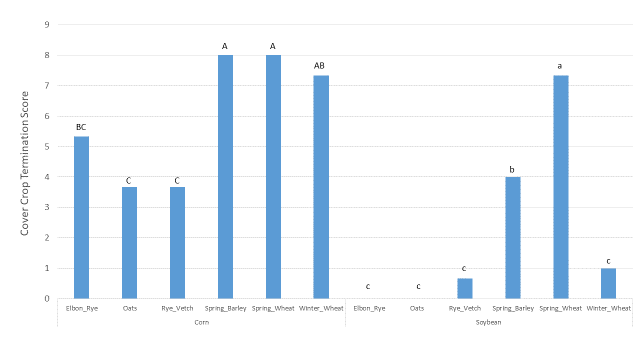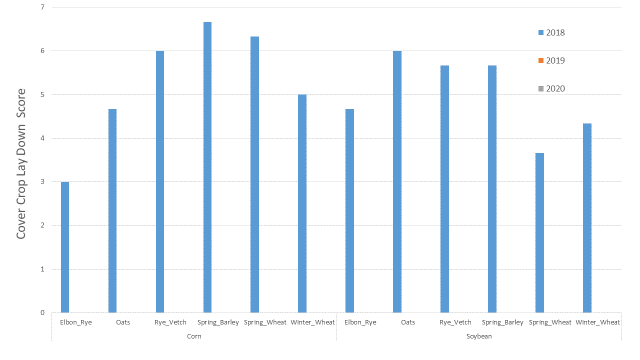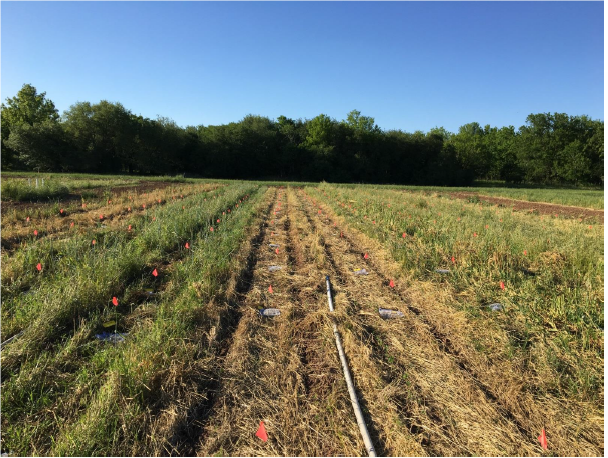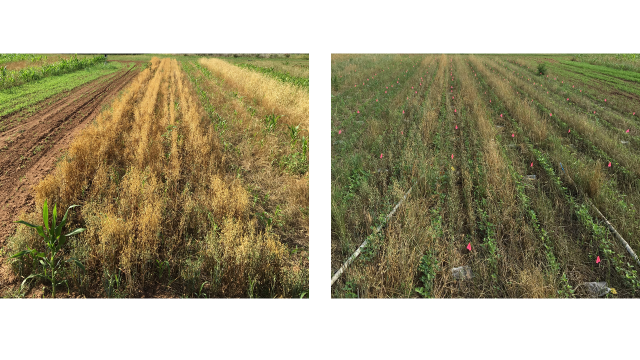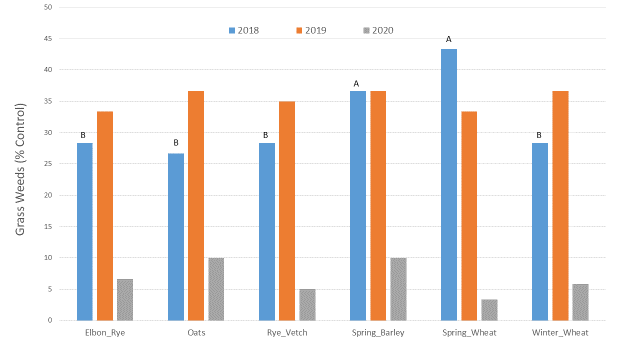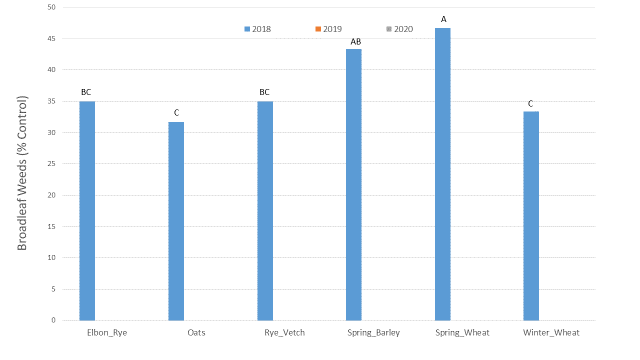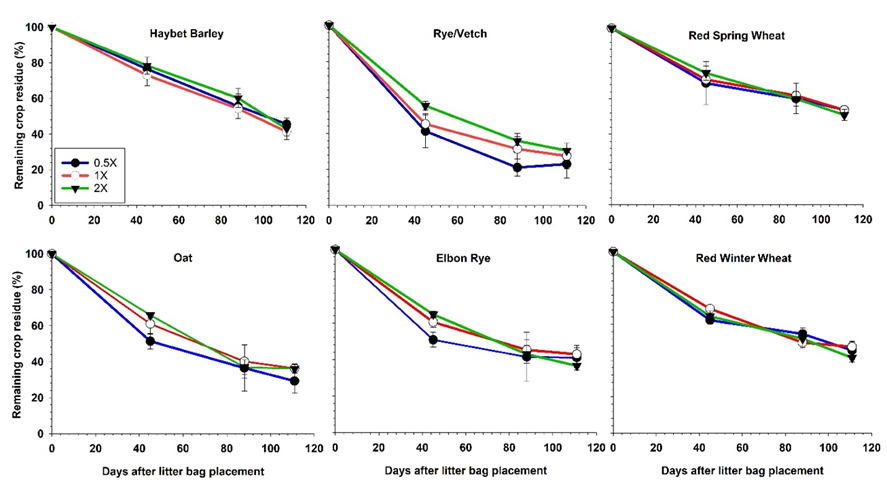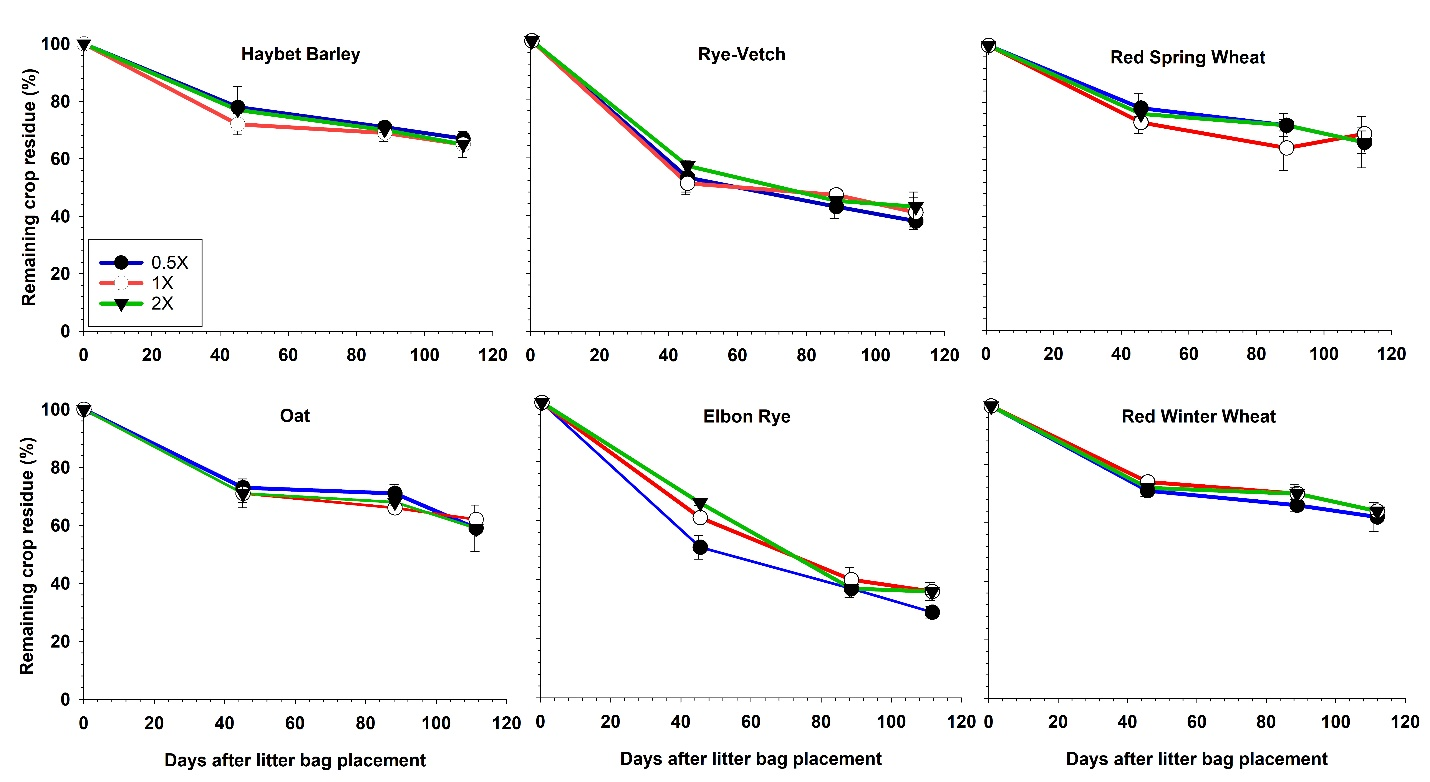Final report for LS17-283
Project Information
Texas ranks first in number of farms and third in total agricultural production in the U.S. However, the state lags behind in organic crop production. The low rate of adoption of organic farming for grain crops such as corn and sorghum has been a major bottleneck for expansion of the organic livestock sector in this state. The specific goals of this study are based on our interactions with farmers and other stakeholders in the region. Collectively, these discussions have shaped the goals and objectives of the project. Our goals are: (1) Conduct research and onfarm demonstrations in a partnership between scientists and stakeholders for greater understanding of the influence of cover cropping in no-till organic systems on soil fertility, weed dynamics, wateryield relations, and soil health, (2) Develop best management practices that optimize both agricultural profitability and ecosystem services in transitioning cropping systems (corn and soybeans), (3) Develop an educational and outreach program for efficient transfer of project results to the various stakeholders and organize training efforts on the certification process, farm plan development, environmental benefits, and best management strategies while transitioning to organic production. Through this project, we will address some of the critical needs of farmers and other stakeholders in Texas who plan to adopt organic farming.
- Conduct research and onfarm demonstrations in a partnership between scientists and stakeholders for greater understanding of the influence of cover cropping in no-till systems on weed dynamics, soil-water relations and crop yield for organic grain cropping systems (corn and soybean).
- Develop best management practices that optimize both agricultural profitability and ecosystem services in organic cropping systems (corn and soybean).
- Develop an educational and outreach program for efficient transfer of project results to the various stakeholders and organize training efforts on organic certification process, farm plan development, environmental benefits, and best management strategies for cover crops and tillage practices while transitioning to organic
Cooperators
- - Producer
Research
Materials and methods:
A three-year organic cover crop system experiment was established during the summer of 2017 at College Station, TX. This is managed according to NOP-guidelines with large buffer zones, as land will be transitioned to certified organic. The experimental design is a randomized block design with four replications for corn and soybeans, both crops grown each year in rotation. Cropping systems will focus on corn and soybeans to provide contrasting planting window requirements. Yield goals for system development are 125 bu/acre for corn and 40 bu/acre soybeans. Experimental units are 4 rows wide (3 m) by 46 m in length. The main soil type is clay. We imposed six experimental cover crop systems for each main crop to evaluate: cover crop productivity and termination efficacy, weed suppression potential, nutrient balance, water use, grain yield and economic return. Light disking was performed prior to drilling winter cover crops. All grain crops were planted on 76.2 cm rows using a John Deere 1705 4-row no-till planter. No-till attachments included Yetter residue managers and coulters. Harvest was performed by hand or using a John Deere 3300 combine with HarvestMaster weigh system. Manure was spread using a High Roller broadcast spinner applicator on a 9 m swath. All crops received approximately 75 kg N ha-1 and no more than 25 kg P ha-1 from manure or compost sources. Rates varied by nutrient content of source material. Soil nutrient levels did not vary over time by main crop or cover crop despite limited nutrient export with annual manure/compost applications.
|
Year |
Product |
N % |
P % |
K % |
|
2018 |
Broiler Litter |
2.52 |
1.23 |
3.87 |
|
2019 |
Turkey Compost |
1.11 |
0.18 |
0.35 |
|
2020 |
Broiler Litter |
3.92 |
0.94 |
2.77 |
|
Year - Crop |
NO3-N |
P |
K |
|
------------------------------------------mg kg-1---------------------------------- |
|||
|
2018 Corn |
7.16 |
23.81 |
289.6 |
|
2018 - Soybean |
6.70 |
18.53 |
258.9 |
|
2020 - Corn |
10.7 |
22.9 |
297.9 |
|
2020- Soybean |
10.5 |
25.5 |
318.4 |
Cover Crop Fall 2017
Cowpea (Vigna unguiculata L.) cover crop was planted on September 7, 2017 proceeding planting of cover crops for corn or soybean rotations. Biomass of cowpeas was measured and N content determined to estimate N input. The cowpea was shredded and incorporated before planting of fall cover crops. The experimental cover crop systems included six contrasting species planted on November 7, 2017 proceeding corn or soybean. Cover crop selections included Haybet Barley (Spring), Glenn Hard Red Spring Wheat, TAM EXP Oats, Rye/Vetch, Elbon Rye, and Fannin Hard Red Winter Wheat. All cover crop were planted at 112 kg ha-1. Cereal rye has been investigated extensively in cover cropping and organic systems. This will serve as a base-line for comparing results to other regions and systems. Cover crop biomass was measured by subsampling 1 m segments at three points within each plot. Cover crop was terminated using a cotton stalk roller. Soil was sampled prior to planting grain crops.
Grain Crops Spring 2018
Corn was planted using Prairie Hybrid PH7387 at 32,000 seeds/A on 3/22 and replanted on 4/13. Replanting was required due to poor stands as a result of insect damage from wireworms and seed maggots. Soybean was planted on 4/6 using Progeny Seed P4910 at 140,000 seeds/A.
Cover Crop Fall 2018
Cover crop systems included six contrasting species planted on November 30, 2018. Cover crop selections included Star Seed Haybet Barley (Spring), Johnny’s Glenn Hard Red Spring Wheat, Urban Farmer Rye/Vetch, TAM 606 EXP Oats, Rye/Vetch, Elbon Rye, and TAM 114 Hard Red Winter Wheat. Cover crop planting in 2018 was delayed due to excessive rainfall in the region. The target planting date was in September. All cover crops established good stands. Cool and wet weather combined with later planting to limit growth. Volunteer Italian ryegrass was a major weed in all cover crops. Cover crop biomass was measured by removing weeds and cutting cover crop biomass only. Cover crop was not tall enough or mature enough by either grain plant date for effective crimper rolling for termination. Soil was sampled prior to planting grain crops.
Grain Crop Spring 2019
Cover crop growth was insufficient (height, maturity) for mechanical termination. Strip tillage was performed on 3/21/19 to improve planting conditions. Corn was planted on 3/28/19 at 29,000 seeds/A. Soybean was planted on 4/3/19 at 150,000 seeds/A. Stands were adequate for bother crop within 2 weeks after emergence.
Cover Crop Fall 2019
Cover crop systems included six contrasting species planted on October 4th, 2019. Cover crop selections included Star Seed Haybet Barley (Spring), Johnny’s Glenn Hard Red Spring Wheat, Urban Farmer Rye/Vetch, TAM 606 EXP Oats, Rye/Vetch, Elbon Rye, and TAM 114 Hard Red Winter Wheat. Cover crop planting in 2019 was completed by the target planting date. All cover crops established good stands.
Grain Crop Spring 2020
Cover crop growth was poor and density of winter weeds (ryegrass) resulted in in-effective mechanical termination. Strip tillage was performed on 2/28/19 to improve planting conditions. Corn was planted on 3/10/20 at 29,000 seeds/A. Soybean was planted on 4/1/20 at 150,000 seeds/A. Stands were adequate for bother crop within 2 weeks after emergence.
Cover Crop Decomposition
A field study and laboratory study were conducted to evaluate decomposition and nutrient cycling through contrasting cover crop species. A litterbag study was conducted under field conditions for two years. Litterbags (30 x 30 cm) were filled with 0.5, 1, and 2x rates of cover crop biomass and placed in the field. Bags were arranged to be consistent with roller crimped biomass and were harvested on 40-day intervals. Change in mass over time was measured and used to estimate percent residue remaining throughout the season (grain crops). Cover crop biomass rates were based on 2018 cover crop biomass yields.
Cover Crop Biomass Yield
Cover crop biomass varied by species and year. Cover crop biomass declined each year of the study period. Mean cover crop biomass was 4.3 Mg ha-1 in 2018 and decreased to 0.6 Mg ha-1 in 2020. Variation in cover crop biomass was affected by competition with winter weeds, which increased in coverage during the study period. Variation in agronomic practices (planting date, fertility, etc.) did not affect cover crop productivity. Establishment was good each year and environmental conditions were sufficient for cover crop growth. Cover crop biomass was not estimated in 2019 due to contamination of samples with winter weeds, primarily Italian ryegrass. It was estimated that ryegrass represented >50% of total biomass in all plots. Ryegrass was separated from cover crop biomass during clipping to estimate cover crop biomass in 2020.
Despite declining biomass production over time, variation in biomass production was observed among species evaluated. No difference was observed due to later termination dates associated with soybeans compared to corn termination timing. Therefore, mean cover crop dry matter is presented by year (except 2019 where weed contamination prevented accurate estimation of cover crop biomass). Spring barley, spring wheat, and oats consistently outperformed (p<0.05) elbon rye and rye/vetch mixtures (Figure 1). Mean dry matter yields for spring type cereals and oats were 2.2-fold greater than elbon-rye and rye/vetch mixtures. When growth is heat unit dependent and does not require vernalizing, it enables greater biomass production during the Fall and warm periods encountered during the Winter in central and south Texas. This confirms that selecting spring types will enable greater biomass production ahead of planting dates used in Texas for corn and soybean. This is in contrast to other regions of the U.S. where rye and similar cereals have performed well in organic and conventional systems.
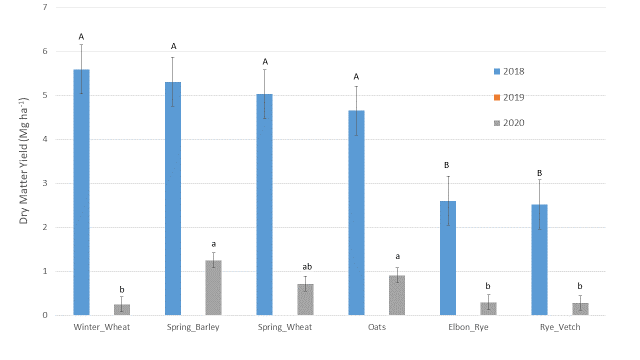 Figure 1. Cover crop dry matter production (Mg ha-1) by year, presented as means of corn and soybean cover crops. Error bars represents standard error of the mean. The same letter above a bar indicates means are not significantly different (p>0.05) using L.S.D.
Figure 1. Cover crop dry matter production (Mg ha-1) by year, presented as means of corn and soybean cover crops. Error bars represents standard error of the mean. The same letter above a bar indicates means are not significantly different (p>0.05) using L.S.D.
Cover Crop Termination Efficacy
Termination efficacy was evaluated on a 0-9 scale using visual ratings for kill, planter row cleaning, and laydown. A score of zero rating no kill, unclean planter row, or cover crop that was completely erect 2 weeks after planting.
Efficiency of cover crop termination was dependent on cover crop species and level of biomass present. Ratings for cover crop kill declined in year 2 and 3 as cover crop biomass declined and amount of ryegrass weed biomass increased. There was no difference in kill rating across species or timing in 2019 or 2020. In 2018, there was a significant difference (p <0.05) between termination timing (corn or soybean schedule) and cover crop species. Similar to biomass production, Spring barley and Spring wheat resulted in better kill following roller crimping compared to elbon rye or rye/vetch mixture. Unexpectedly, cover crops terminated better ahead of corn planting (earlier) than soybeans. In addition, despite similar levels of biomass production oats to spring cereal types, oats were not successfully terminated by roller crimping.
Figure 2. Efficacy of termination of cover crops ahead of corn or soybean planting by roller crimping. Score of 0 indicates no kill, 9 indicates complete kill. Bars with the same letter are not significantly different (L.S.D. p = 0.05).
Figure 3. Rating on laydown for contrasting cover crops in corn and soybean cropping systems. All ratings in 2019 and 2020 were 0.
Cover crops were rated for laydown at two weeks after planting with 0 indicating erect plants and 9 indicating complete laydown. This was measured at 3 to 4 weeks following mechanical termination using a roller crimping device. As with termination (kill) ratings, the amount of biomass and maturity was expected affected the cover crops ability to recover and remain erect following termination. However, no significant difference was observed between cover crop species or termination timing. Cover crop in 2018 (with greater biomass) did lay down and stay down better than the following 2 years. Poor biomass production in 2019 and 2020, combined with ryegrass contamination produced short plants that lacked the height required for sucessful mechanical termination. This is evident by mean laydown ratings in 2019 and 2020 less than 1 compared to 5.1 in 2018. The lack of good laydown ratings in any year for any species indicates that the dense layer that is expected to serve as a weed barrier during grain production never materialized. Visual differences in laydown were observed in 2018 for individual plots, yet, variation precluded statistical differences (Figure 4).
Figure 4. Image of cover crop after planting. Variation in kill, laydown, and planter rows following mechanic termination are shown.
Creating a clean planted row is expected to improve seedling establishment for corn and soybean. The planter used was fitted with Yetter row cleaner and coulters for no-till planting into heavy residue (Figure 4). Variation in planter row scores was observed every year and across cover crop species (Figure 5). Planter rows appeared clean at the time of planting. However, living and even dead residue eventually covered planted rows, creating a competitive environment for establishing crops (Figure 6). Notice the plant outside of the cover crop in Figure 6. Presence of ryegrass weeds which persisted for almost two months into the season (corn and soybean) resulted in severe limitations to crop growth and diminished efforts at planting to provide optimum environments for corn and soybean growth.
Figure 5. Rating for how clean planter rows were about two weeks after planting. 9 = clean rows, 0 = complete covering of planted rows.
Figure 6. Corn and soybean stands within contrasting cover crop species. The plant outside of the cover crop area illustrates the impact weed and cover crop residue had on growth of corn and soybeans.
Weed Control
Weed control ratings for contrasting cover crops were determined prior to planned harvest of corn or soybean. Ratings provided are visual estimates of percent control. No difference was observed between corn or soybean, ratings represent the mean of grain crops for each cover crop. Grass weed control ranged from 32.9 to 35.3 % in 2018 and 2019, declining to 6.8% in 2020. In 2018, Spring wheat and Spring Barley provided a small improvement of grass weed control compared to all other cover crops. Regardless of variation in grass weed control, weed control was not adequate and declined over time in a no-till cover crop system.
Figure 7. Impact of cover crops on grass control. Mean of weed ratings for corn and soybean are provided. Bars with the same letter above are to significantly different (L.S.D, p=0.05).
Similar to grass weed control by cover crops, small differences were observed in 2018 with Spring wheat and Spring barley showing better control than other cover crop species (Figure 8). Mean % control of broadleaf weeds was 37.5% in 2018 and declined rapidly to 0% control in 2019 and 2020. We speculate that winter weeds (ryegrass), combined with cover crop residue contributed to an environment that enable broadleaf weed infestation in grain crops, especially late-season. Lack of sufficient residue to develop dense mats of residue during roller crimping that lay down and remain down to provide shading of soil between rows was evident. As cover crop productivity declined with time, lack of weed control was exacerbated.
Figure 8. Impact of cover crop species on % control (visual rating) of broadleaf weeds. Values represent the mean of grain crops for each cover crop. Bars with the same letter are not significantly different (L.S.D. p=0.05).
Crop Yields
There was no harvestable yield from either corn or sorghum in 2018. In 2019 there was no harvestable corn yield, however soybeans were harvested on September 6th, 2019 by hand from two 10 m lengths from the center two rows. There was no difference in soybean yield between any of the cover crop species (Figure 9). No harvestable yield was produced in 2020 for corn or soybean.
Soybean yield
|
Cover Crop |
Yield |
|
Barley |
1.03 |
|
Elbon Rye |
0.87 |
|
Spring Wheat |
1.43 |
|
Winter Wheat |
1.29 |
|
Oats |
1.18 |
|
Rye/vetch |
1.09 |
Figure 9. Yield for soybean in 2019 adjusted to 13% moisture. Yields were not significantly different (p=0.05).
While variation in cover crop biomass, termination efficacy, and weed control were observed for contrasting cover crop species at planting, weeds and/or living cover crop biomass severely limited crop growth and development. Efforts to provide clean planted rows did not persists through early growth stages. Stands were generally adequate, however, weed and cover crop biomass quickly recovered, shading establishing corn and soybean plants. Competition for light, water, and nutrients resulted in poor grain crop performance (Figure 6). Contamination of cover crops with winter weeds, primarily Italian ryegrass, likely had greater impact than summer weeds. Ryegrass weeds aggressively competed with cover crops reducing cover crop performance (dry matter yield) and aggressively competed with establishing corn and soybean plants. Ryegrass persistence was progressively worse throughout the study period suggesting cover crops had little influence on ryegrass populations. Alternative management practices should be explored when ryegrass is present in organic grain fields. This may include strategic tillage to control ryegrass seedlings and to reduce weed seed banks.
Cover Crop Decomposition
Cover crop biomass used for litterbag studies under field conditions revealed that cover crop species affected decomposition rates for residue placed on the soil surface. Rates at 0.5 and 2 X decomposed at rates similar to 1 x rates (representing 2018 cover crop biomass yields). This indicates that variation in biomass yields annually will not affect percent of residue amounts that remain on the soil surface during grain production. Cover crop species or mixes did decompose at different rates. Following 120 days on the soil surface, mean (combined rates) amount of residue remaining ranged from 27 to 69% (Figure 10-12)). In 2018 and 2019, Spring wheat, Spring Barley, and Winter wheat retained greater (p < 0.05) amounts of residue compared to other cover crops. Greater C:N ration of residue contributes to slower decomposition rates (Figure 13). Greater biomass and lower decomposition rates of Spring type cover crops likely contributed greater shading of soil surface and increased weed control in 2018. This benefit declined as cover crop biomass declined and winter weed biomass increased over time.
Figure 10. Percent of remaining cover crop residue by weight in the litter bags in 2018. Error bars in the line graph are the standard errors of the mean.
Figure 11. Percent of remaining cover crop residue by weight in the litter bags in 2019. Error bars in the line graph are the standard errors of the mean.
|
Cover crop |
2018* |
2019 |
|
Haybet barley |
43.22bc |
65.77a |
|
Red spring wheat |
52.88a |
66.90a |
|
Oat |
34.11d |
60.07b |
|
Rye-vetch |
27.00e |
40.58d |
|
Elbon rye |
40.11c |
54.70c |
|
Red winter wheat |
45.00b |
63.51a |
Figure 12. Percent remaining biomass weight of cover crops residue at harvest on litter bag experiment during 2018 and 2019.
|
Cover rops |
2018* |
|
2019 |
||||
|
%N |
CN ratio |
% Lignin |
|
%N |
CN ratio |
% Lignin |
|
|
Haybet barley |
1.12d |
37:1a |
2.7b |
|
1.00 |
40.33ad |
- |
|
Red spring wheat |
1.23cd |
34:1ab |
3.3bc |
|
1.13 |
34.33b |
- |
|
Oat |
1.83b |
24:1bc |
2.5b |
|
0.96 |
42.67a |
- |
|
Rye-vetch |
2.53a |
17:1c |
4.7a |
|
1.96 |
20.67c |
- |
|
Elbon rye |
1.47c |
31:1ab |
5.0a |
|
1.13 |
36.00 |
- |
|
Red winter wheat |
1.50c |
29:1b |
4.1ac |
|
1.03 |
37.00 |
- |
Figure 13. Tissue composition of cover crop residue at harvest in 2018 and 2019. *Means followed by the same letters in the column are not significantly different.
Education
The education component included a training program for organic grain production and traditional classroom and field-based educational events. The training program consist of 6 modules covering various topics related to organic grain production. Module 1 starts with an overview of organic systems and it progresses to more advanced topics. Training material consist of a MS Publisher handout, providing greater detail of each topic, and a MS PowerPoint presentation to guide discussion of each topic. Trainer and trainee versions are available with the long-term goal for CEAs to deliver the material after completing the training. Covid protocols have limited in-person meetings in 2020. More advanced topics are intended to be interactive group activities that are more suitable for in-person meetings. We are currently developing methods for adjusting to remote formats. Introductory training modules have been presented at 3 training events, all remotely delivered. Training and module refinement will continue.
Training Modules:
- Module 1: Introduction to Organic
- Current Organic Production in Texas
- Overview of USDA and NOP
- Terms and definitions
- Brief certification review
- Module 2: The Certification Process
- Overview of Certification Process
- Application, Review, Inspection, and Review
- Certification
- Module 3: Developing a Farm Plan
- General farm plan information
- Seeds and Seed Treatments and Sources
- Soil and Crop Fertility Management
- Crop Management
- Maintenance of Organic Integrity
- Record Keeping Systems
- Module 4: Managing Soil Fertility and Soil Health
- Soil characteristics, testing and monitoring
- Soil fertility management strategies
- Using compost as an amendment
- Using manure as an amendment
- Maintaining soil as a natural resource
- Using and irrigation system
- Module 5: Crop Management
- Seed sourcing and treatments
- Crop rotation strategies
- Cultural weed management, restrictions, and monitoring
- Pest management cultural and biological strategies
- Disease management and prevention
- Crop management record requirements
- Module 6: Maintaining Organic Integrity
- Adjoining land and buffer area use and maintenance
- Monitoring crop contamination with equipment and in the field
- Harvest requirements and strategies
- Post-Harvest handling and storage
Educational & Outreach Activities
Pokhrel, Pramod; Rajan, Nithya; Schnell, Ronnie W; Estimating Organic Carbon and Nitrogen Mineralization from Winter Cereal Cover Crops Residue in Organic Crop Production Systems ASA, CSSA and SSSA International Annual Meetings (2019) 2019 ASA, CSSA, and SSSA
Moreno, Jonathan; Schnell, Ronnie W; Rajan, Nithya; Bagavathiannan, Muthukumar; Impacts of Tillage and Cover Cropping on Organic Systems. ASA, CSSA, and CSA International Annual Meeting 2018 ASA, CSSA, and SSSA
Zapata, Diana; Rajan, Nithya; Schnell, Ronnie W; Greenhouse Gas Emissions from Organically Managed Cropping Systems in Texas. ASA, CSSA, and CSA International Annual Meeting 2018 ASA, CSSA, and SSSA
Zapata, Diana; Rajan, Nithya; Moreno, Jonathan; Schnell, Ronnie W; Nair, Shyam; Casey, Kenneth D; Transitioning into Organic Grain Production in Texas: Challenges and Environmental Impact ASA, CSSA and SSSA International Annual Meetings (2019) 2019 ASA, CSSA, and SSSA
Zapata, Diana; Rajan, Nithya; Casey, Kenneth D; Schnell, Ronnie W; Mowrer, Jake E; Carbon and Nitrogen Mineralization of Cereal and Legume Cover Crop Residues in Organic Soils. ASA, CSSA, and CSA International Annual Meeting 2018 ASA, CSSA, and SSSA
Zapata, Diana; Rajan, Nithya; Casey, Kenneth D; Mowrer, Jake E; Schnell, Ronnie W; Linking Carbon Dioxide and Nitrous Oxide Emissions from Crop Residue Decomposition ASA, CSSA and SSSA International Annual Meetings (2019) 2019 ASA, CSSA, and SSSA
Samuelson, Spencer L; Rajan, Nithya; Schnell, Ronnie W; Bagavathiannan, Muthukumar; Impact of Non-Chemical Management Practices on Weed Population Dynamics in Organic Grain Production ASA, CSSA and SSSA International Annual Meetings (2019) 2019 ASA-CSSA-SSSA
Pokhrel, Pramod; Rajan, Nithya; Schnell, Ronnie W; Zapata, Diana; Effect of Cover Crop Residues on Soil Organic Carbon Mineralization in an Organic Soybean Production System. ASA, CSSA, and CSA International Annual Meeting 2018 ASA, CSSA, and SSSA
Participation Summary:
Study results were shared at several producer education events and field days. At in-door education events, the use of cover crop in grain systems was discussed. This included species selection and logistics surrounding productivity and termination for various grain crop production. Attendee numbers ranged from 30 to approximately 90. In addition to agronomic discussion, general discussion of organic systems and certification was help with groups and individuals. Field days were used to showcase cover crop systems to producers, NRCS representatives, and county Extension agents. These events provided hands on demonstration of contrasting cover crop species and production systems. Challenges of mechanical cover crop termination were observed and compared to conventional systems using chemical termination.
Graduate student education was a component of this project to increase student knowledge of organic cropping systems. Field activities provided students with opportunities to become familiar with organic practices and management in addition to advance research procedures for studying cropping systems. Student presented research results at 8 regional and national meetings, published two scientific manuscripts (in preparation) and 2 thesis/dissertations.
Learning Outcomes
Project is in progress. Educational components are under development. Changes in knowledge, etc., will be documented as training events occur.
Project Outcomes
The main concept of this project was to determine if Spring type cereal species would enable greater cover crop productivity and provide more benefits to organic grain systems when used in Central and South Texas compared to other cereal species/mixes. Grain crops are planted much earlier in this region compared to other regions where cover crops, mechanical termination, and no-till planting are commonly used. Traditional cereals, such as cereal rye, develop biomass and mature during periods later than required termination times in this region. Identifying species that are suitable and improve logistics surrounding cover crop use will contribute to sustainable organic grain production in the region.
Spring type cereals (Spring wheat and Spring Barley) did produce greater biomass and mature faster than other species evaluated. In addition, the residue remained longer on the soil surface compared to other species. This provided some benefits for weed suppression early in the experiment. However, no winter cover crop species was effective at competing with ryegrass weeds during winter periods. As a result, ryegrass weed populations increased over time and reduced cover crop performance over time. This issue must be addressed to realize potential benefits of cover crops for weed suppression in grain crops.
Despite struggles with winter weeds in organic cover crop systems, we did gather enough information to adjust species recommendations for cover crop systems in Texas. This information is currently being used in other studies under conventional and organic management with success. Observations at other field sites confirm our conclusions about productivity and potential of Spring type cereals in the region.
Controlling annual ryegrass has been an issue in conventional systems, with an array of herbicides available for control and the development of herbicide resistance. Controlling ryegrass weeds in organic systems is very difficult as well. At this point, we would not recommend the use of cover crops as a weed barrier for following grain crops when ryegrass is present. Cover crops could be used, however, we would recommend tillage to incorporate residue and destroy ryegrass rather than attempting no-till planting. Alternative methods for controlling ryegrass in organic systems should be explored. Ryegrass is devastating for grain production in conventional and organic systems.
